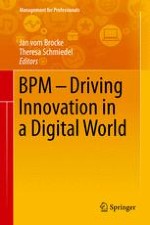2015 | OriginalPaper | Chapter
On the Importance of Non-technical Process Capabilities to Support Digital Innovations
Author : Amy Van Looy
Published in: BPM - Driving Innovation in a Digital World
Publisher: Springer International Publishing
Activate our intelligent search to find suitable subject content or patents.
Select sections of text to find matching patents with Artificial Intelligence. powered by
Select sections of text to find additional relevant content using AI-assisted search. powered by
